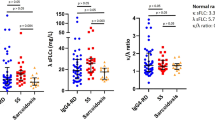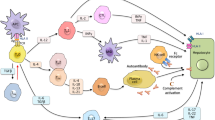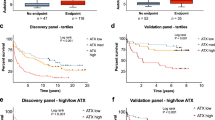Abstract
Hyper-immunoglobulin M syndrome is an X-linked primary immunodeficiency disease caused by mutations in the CD40 ligand gene. The CD40 ligand has been recently highlighted as playing a key role in the pathogenesis of primary biliary cholangitis. In the present study, we assessed an extensive set of serum autoantibodies in a series of well-defined patients with hyper-immunoglobulin M syndrome. Serum, liver-related and liver-not-related autoantibodies IgG, IgM and IgA were tested by ELISA and standard indirect immunofluorescence in HEp-2 cells in 13 Tunisian patients (8 males and 5 females, aged 1–12 years) with hyper-immunoglobulin M syndrome during 1995–2012 and, as controls, 21 age- and gender-matched blood donors. The level of IgM antibody against MIT3 was significantly higher in patients than in controls (35.8 vs 10.7, P=0.002). Half of the hyperimmunoglobulin M syndrome patients were found to be anti-MIT3 IgM positive vs none of the controls (P<0.0001). Twenty-three percent of patients were found to be anti-sp100 antibody positive vs only 0.05% of controls. By immunofluorescence, 92.3% of patients were MIT3 IgM positive vs none of the controls. In conclusion, the IgM class of anti-MIT3 antibodies was shown to be present by both ELISA and immunofluorescence in most of the patients with hyper-immunoglobulin M syndrome. The presence of the hallmark of primary biliary cholangitis, a disease where the CD40 ligand is a key player, in an immunodeficiency disease caused by mutations in the CD40 ligand gene is very intriguing and opens new scenarios in understanding the immune pathogenesis of primary biliary cholangitis.
This is a preview of subscription content, access via your institution
Access options
Subscribe to this journal
Receive 12 digital issues and online access to articles
$119.00 per year
only $9.92 per issue
Buy this article
- Purchase on Springer Link
- Instant access to full article PDF
Prices may be subject to local taxes which are calculated during checkout


Similar content being viewed by others
References
Ehrenstein MR, Notley CA. The importance of natural IgM: scavenger, protector and regulator. Nat Rev Immunol 2010; 10: 778–786.
Duarte-Rey C, Bogdanos DP, Leung PS, Anaya JM, Gershwin ME. IgM predominance in autoimmune disease: genetics and gender. Autoimmun Rev 2012; 11: A404–A412.
Karaca NE, Durandy A, Gulez N, Aksu G, Kutukculer N. Study of patients with hyper-IgM type IV phenotype who recovered spontaneously during late childhood and review of the literature. Eur J Pediatr 2011; 170: 1039–1047.
Davies EG, Thrasher AJ. Update on the hyper immunoglobulin M syndromes. Br J Haematol 2010; 149: 167–180.
Herve M, Isnardi I, Ng YS, Bussel JB, Ochs HD, Cunningham-Rundles C et al. CD40 ligand and MHC class II expression are essential for human peripheral B cell tolerance. J Exp Med 2007; 204: 1583–1593.
Wolpert KA, Webster AD, Whittaker SJ. Discoid lupus erythematosus associated with a primary immunodeficiency syndrome showing features of non-X-linked hyper-IgM syndrome. Br J Dermatol 1998; 138: 1053–1057.
Gulino AV, Notarangelo LD. Hyper IgM syndromes. Curr Opin Rheumatol 2003; 15: 422–429.
Lougaris V, Badolato R, Ferrari S, Plebani A. Hyper immunoglobulin M syndrome due to CD40 deficiency: clinical, molecular, and immunological features. Immunol Rev 2005; 203: 48–66.
Jesus AA, Duarte AJ, Oliveira JB. Autoimmunity in hyper-IgM syndrome. J Clin Immunol 2008; 28 (Suppl 1): S62–S66.
Ouadani H, Ben-Mustapha I, Ben-ali M, Ben-khemis L, Larguèche B, Boussoffara R et al. Novel and recurrent AID mutations underlie prevalent autosomal recessive form of HIGM in consanguineous patients. Immunogenetics 2016; 68: 19–28.
Ouadani H, Ben-Mustapha I, Ben-Ali M, Larguèche B, Jovanic T, Garcia S et al. Activation induced cytidine deaminase mutant (AID-His130Pro) from Hyper IgM 2 patient retained mutagenic activity on SHM artificial substrate. Mol Immunol. 2016; 79: 77–82.
Hayward AR, Levy J, Facchetti F, Notarangelo L, Ochs HD, Etzioni A et al. Cholangiopathy and tumors of the pancreas, liver, and biliary tree in boys with X-linked immunodeficiency with hyper-IgM. J Immunol 1997; 158: 977–983.
Quartier P, Bustamante J, Sanal O, Plebani A, Debre M, Deville A et al. Clinical, immunologic and genetic analysis of 29 patients with autosomal recessive hyper-IgM syndrome due to activation-induced cytidine deaminase deficiency. Clin Immunol 2004; 110: 22–29.
Muratori P, Muratori L, Gershwin ME, Czaja AJ, Pappas G, MacCariello S et al. 'True' antimitochondrial antibody-negative primary biliary cirrhosis, low sensitivity of the routine assays, or both? Clin Exp Immunol 2004; 135: 154–158.
Miyakawa H, Tanaka A, Kikuchi K, Matsushita M, Kitazawa E, Kawaguchi N et al. Detection of antimitochondrial autoantibodies in immunofluorescent AMA-negative patients with primary biliary cirrhosis using recombinant autoantigens. Hepatology 2001; 34: 243–248.
Kaplan MM, Gershwin ME. Primary biliary cirrhosis. N Engl J Med 2005; 353: 1261–1273.
Wolfhagen FH, van Buuren HR, Vleggaar FP, Schalm SW. Management of osteoporosis in primary biliary cirrhosis. Baillieres Best Pract Res Clin Gastroenterol 2000; 14: 629–641.
Invernizzi P, Lleo A, Podda M. Interpreting serological tests in diagnosing autoimmune liver diseases. Semin Liver Dis 2007; 27: 161–172.
European Association for the Study of the Liver. EASL Clinical Practice Guidelines: management of cholestatic liver diseases. J Hepatol 2009; 51: 237–267.
Dahlan Y, Smith L, Simmonds D, Jewell LD, Wanless I, Heathcote EJ et al. Pediatric-onset primary biliary cirrhosis. Gastroenterology 2003; 125: 1476–1479.
Gershwin ME, Ansari AA, Mackay IR, Nakanuma Y, Nishio A, Rowley MJ et al. Primary biliary cirrhosis: an orchestrated immune response against epithelial cells. Immunol Rev 2000; 174: 210–225.
Ehrenstein MR, O'Keefe TL, Davies SL, Neuberger MS. Targeted gene disruption reveals a role for natural secretory IgM in the maturation of the primary immune response. Proc Natl Acad Sci USA 1998; 95: 10089–10093.
Long SA, Van de Water J, Gershwin ME. Antimitochondrial antibodies in primary biliary cirrhosis: the role of xenobiotics. Autoimmun Rev 2002; 1: 37–42.
Selmi C, Balkwill DL, Invernizzi P, Ansari AA, Coppel RL, Podda M et al. Patients with primary biliary cirrhosis react against a ubiquitous xenobiotic-metabolizing bacterium. Hepatology 2003; 38: 1250–1257.
Lleo A, Liao J, Invernizzi P, Zhao M, Bernuzzi F, Ma L et al. Immunoglobulin M levels inversely correlate with CD40 ligand promoter methylation in patients with primary biliary cirrhosis. Hepatology 2012; 55: 153–160.
Selmi C, Gershwin ME. Bacteria and human autoimmunity: the case of primary biliary cirrhosis. Curr Opin Rheumatol 2004; 16: 406–410.
Selmi C, De Santis M, Cavaciocchi F, Gershwin ME. Infectious agents and xenobiotics in the etiology of primary biliary cirrhosis. Dis Markers 2010; 29: 287–299.
Abdulkarim AS, Petrovic LM, Kim WR, Angulo P, Lloyd RV, Lindor KD. Primary biliary cirrhosis: an infectious disease caused by Chlamydia pneumoniae? J Hepatol 2004; 40: 380–384.
Thomas HC, Holden R, Jones JV, Peacock DB. Immune response to phi X 174 in man. 5. Primary and secondary antibody production in primary biliary cirrhosis. Gut 1976; 17: 844–848.
Nakajima M, Shimizu H, Miyazaki A, Watanabe S, Kitami N, Sato N. Detection of IgA, IgM, and IgG subclasses of anti-M2 antibody by immunoblotting in autoimmune cholangitis: is autoimmune cholangitis an early stage of primary biliary cirrhosis? J Gastroenterol 1999; 34: 607–612.
Author information
Authors and Affiliations
Corresponding author
Rights and permissions
About this article
Cite this article
Barbouche, MR., Chen, Q., Carbone, M. et al. Comprehensive review of autoantibodies in patients with hyper-IgM syndrome. Cell Mol Immunol 15, 610–617 (2018). https://doi.org/10.1038/cmi.2017.140
Received:
Accepted:
Published:
Issue Date:
DOI: https://doi.org/10.1038/cmi.2017.140



